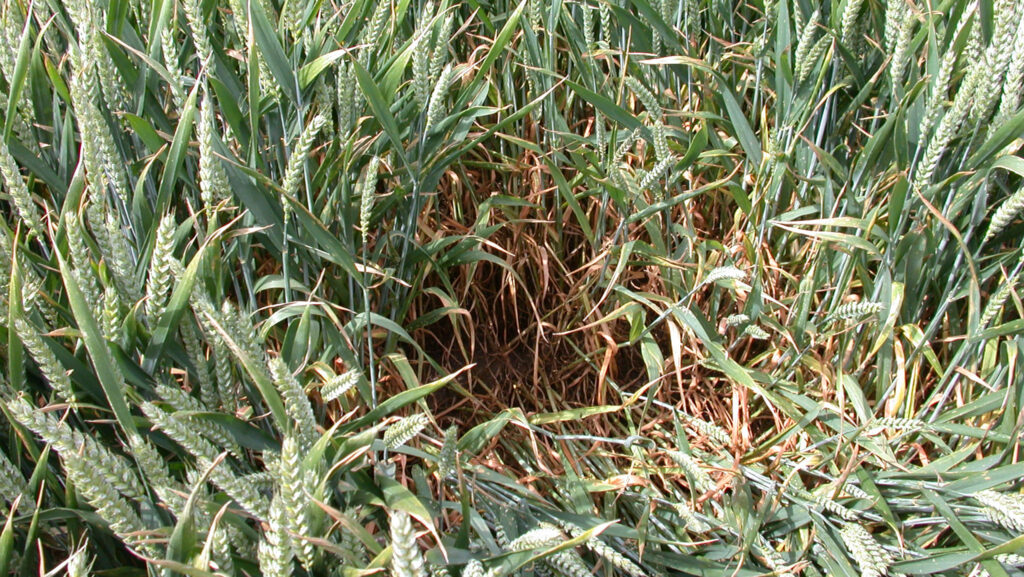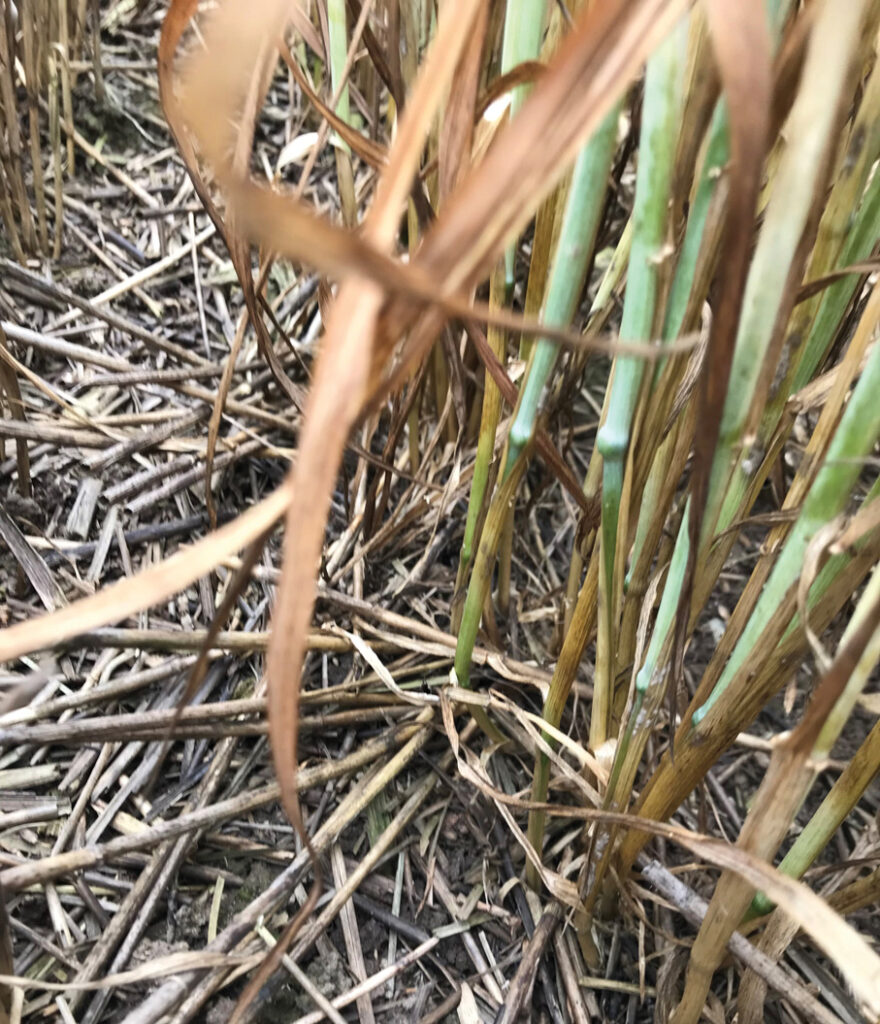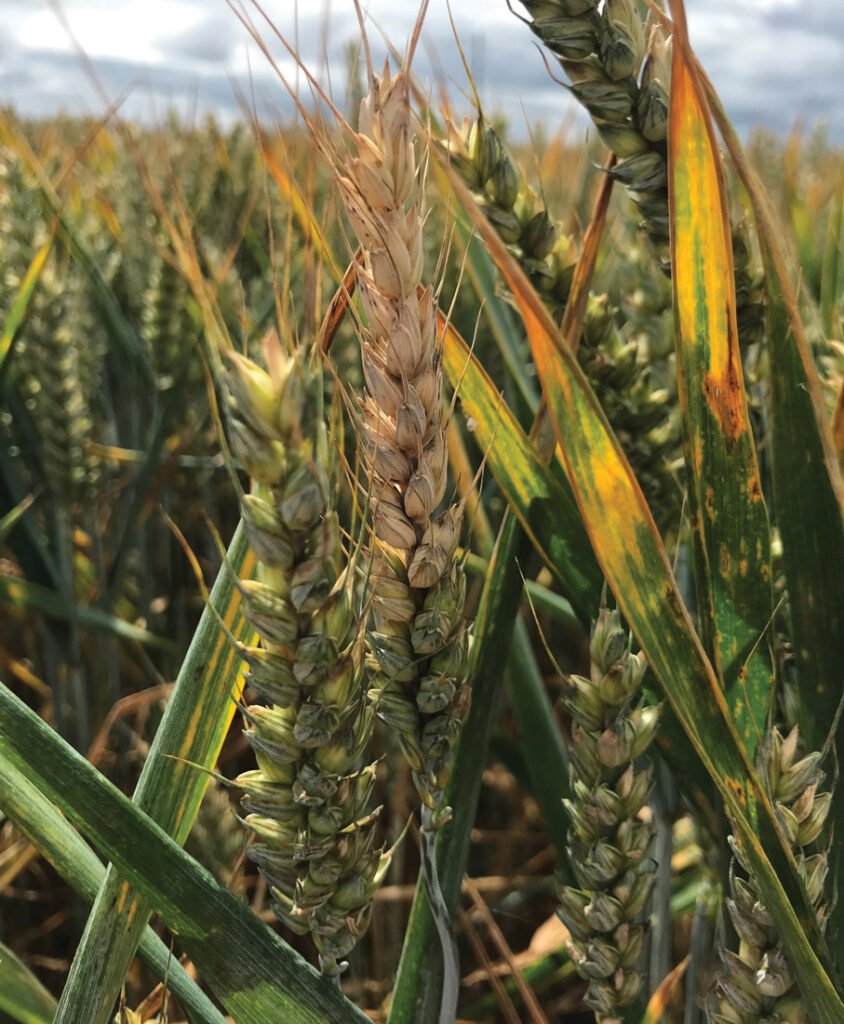An in-depth look at stem- and soil-borne diseases in cereals
 White heads in wheat © Blackthorne Arable
White heads in wheat © Blackthorne Arable While foliar diseases often dominate discussions, stem base and root pathogens in cereals require increasing attention as farming systems evolve. Here, we examine the changing dynamics of these diseases.
Managing stem-base and soil-borne diseases isn’t always a top priority, but changing crop production methods demand a more careful consideration of their impact across rotations.
Prof Rumiana Ray of Nottingham University emphasises that many assumptions about the impact of regenerative farming on disease risks are being made.
See also: Why Essex grower is expanding Scope wheat area this autumn
One such assumption is that improved soil health, achieved through diverse rotations, cover crops, and reduced tillage, will automatically eliminate pathogens.
“There has been a lot of talk about soil health, with much research focused on the soil microbiome or how regenerative practices or biological products can benefit crops and the environment.”
Rumiana Ray

Rumiana Ray is a professor in plant pathology at the University of Nottingham.
She is an expert in the development of novel approaches and field technologies for pathogen/disease detection
“But it worries me that we are not considering any impacts on the pathobiome in these systems,” says Rumiana.
While some pathogens may be suppressed as soil properties and biology change in regenerative systems, there’s limited evidence to confirm these theories.
“It’s equally valid that what might be a good environment for beneficial organisms is also good for pathogens.
“We need a clearer understanding of how changing practices affect field pathogens, subsequent disease pressure, and potential risks to short- and long-term crop productivity,” she notes.
Key diseases of concern include:
- Foot-rot (caused by fusarium and microdochium species)
- Eyespot (Oculimacula yallundae or W-type, and Oculimacula acuformis or R-type)
- Sharp eyespot (Rhizoctonia cerealis)
- Damping off and rots by Rhizoctonia solani
- Take-all (Gaeumannomyces graminis tritici)
These diseases can significantly damage cereal root systems, especially under favourable conditions. Here, we look at each one in detail:
Eyespot

Eyespot causes lesions on the stems of wheat © Blackthorn Arable
Eyespot, alongside sharp eyespot and foot-rot, is becoming increasingly important. Rumiana notes that wheat trials experienced high natural infection last year, leading to substantial yield loss.
W-type is more pathogenic to wheat than other cereals and evidence suggests that the more competitive and virulent W-type has become dominant in field populations.
Eyespot, often referred to as true eyespot, restricts water and nutrient movement, hindering photosynthesis and grain fill after flowering.
“W-type develops more rapidly than R-type and establishes severe lesions on stems earlier, which is why it’s more harmful.
“You won’t always see white heads like with other soil-borne diseases or with R-type eyespot, but W-type can cause lodging, a significant reduction of specific weight, thousand grain weight and up to 20% yield loss,” she explains.

Lodging in a crop of winter wheat caused by W-type eyespot © Rumiana Ray
Heavier, moisture-retentive soils increase eyespot risk, and disease development is favoured by mild, wet conditions. Losses are amplified when dry, hot periods follow flowering.
Early-sown crops and second cereals are more vulnerable, so cereal breaks help reduce inoculum. W- and R-types survive well in soils and can be hosted by grasses (volunteers, cover crops and grassweeds).
Some wheat varieties possess the Pch1 eyespot resistance gene, which is believed to be holding up, but chemical control is less consistent against current eyespot pathogen populations.
Recent research at Nottingham has demonstrated under high disease pressure, eyespot was most effectively reduced by fungicides containing mefentrifluconazole and/or prothioconazole applied to wheat at T1 (GS32).
Single actives were less consistent in reducing pathogen DNA.
Rumiana advises that to control foliar diseases with the same application at T1, growers should consider mixtures of fungicides to protect against multiple targets, including eyespot.
“In our trials, fungicide mixtures of mefentrifluconazole, pyraclostrobin and metrafenone, or isoflucypyram and prothioconazole, produced the highest yield increases (8-20%) in response to treatment against eyespot across artificially inoculated and naturally infected experiments.”
Fusarium and microdochium
Fusarium and microdochium pathogens are seed-, soil- or trash-borne and impact cereals throughout their life cycle.
These pathogens include fusarium species (F avenaceum, F culmorum, F graminearum, F poae and sometimes F langsethiae) and microdochium species (M nivale and M majus).
These fungi cause the fusarium disease complex, affecting seeds, seedlings and mature plants.
M nivale causes severe seedling blight, resulting in pre- and post-emergence plant death and poor establishment of wheat and barley.
F avenaceum can be underestimated, especially in barley crops following potatoes, legumes and oilseed rape.
“F avenaceum is little different from other fusarium species that are adapted to wheat, because it can survive and cause diseases on a more diverse range of plant hosts,” explains Rumiana.
Foot-rot, associated with fusarium and microdochium, becomes apparent during early stem extension as browning of stem internodes and dark streaks on outer leaf sheaths.

Stem base browning under no tillage © Rumiana Ray
These symptoms serve as a source of inoculum for fusarium head blight (FHB) later in the season.
If dry conditions prevail in spring and summer, spore production on these superficial lesions generates inoculum for FHB infection at flowering.
These spores are then dispersed onto wheat heads by rainfall, leading to the appearance of bleached spikelets, orange/pink masses of spores, or discrete water-soaked lesions.
FHB results in shrivelled grains and mycotoxins, causing rejection by end users.

Bleached spikelets is one symptom of fusarium head blight © Rumiana Ray
Highly resistant wheat cultivars are limited, and barley crops are also susceptible, leading to reduced malting and brewing quality.
Rotation and ploughing down trash are effective at reducing fusarium inoculum, but since many farms no longer plough and have plenty of host crops in the rotations, including maize, eliminating risk is impossible.
“Key is reducing inoculum quantity and its availability for infections. If farmers are using home-grown seed: test the seed and use a seed treatment, where needed, to prevent seedling blight and reduce foot-rot occurrence.
“Consider also soil-borne or debris inoculum that may contribute to fusarium diseases in fields with frequent host rotations and minimum tillage.”
Fludioxonil-containing seed treatments are effective against seed- and soil-borne fusarium and microdochium infection.
For example, a sedaxane plus fludioxonil seed treatment increases plant emergence, reduces damping-off and brown foot-rot, and provides protection against multiple soil-borne pathogens – including Rhizoctonia cerealis and Microdochium nivale – resulting in yield increases of up to 4%.
Rhizoctonia
The rhizoctonia pathogens, R cerealis and R solani, are also part of the complex of soil-borne diseases affecting roots and/or stems of cereal crops.
R cerealis causes sharp eyespot, which is difficult to distinguish from eyespot, particularly in mixed lesions.
According to AHDB, average annual yield losses are 0.5%, but can reach 25% in severe cases associated with take-all.
R cerealis overwinters as mycelium on infected stubble, cereal volunteers, and grassweeds.
“Rotation can reduce available inoculum for sharp eyespot, but it won’t eradicate the pathogen if debris or alternative hosts are around,” says Rumiana.
Ploughing can disrupt the mycelial networks of R cerealis, but can encourage more damaging eyespot, so she recommends prioritising risk assessment and management.
(See the AHDB’s Eyespot in cereals and risk assessment in wheat).
Both R solani and R cerealis can cause seedling diseases in wheat, though less severe than seedling blight caused by M nivale.
Rhizoctonia solani is a diverse complex of isolates classified into anastomosis groups (AGs). The pathogen produces sclerotia, enabling long-term survival in the soil.
Rhizoctonia diseases are favoured by dry, well-structured soils and minimum tillage practices.
The most common AG in English arable soils with winter wheat is AG2-1. This is weakly pathogenic to wheat but can vary in virulence to other hosts in rotations.
This makes the management of this pathogen with rotation on a typical arable farm difficult, although excluding Brassica species can reduce AG2-1 inoculum in soils.
The most virulent isolates of R solani to cereals are grouped in AG 8, which is currently low in incidence in English soils.
However, it is a major issue in arid cropping systems, such as Australia, where it causes “bare patch”.
The disease could become an issue in the UK with increasing temperatures and droughts.
Early symptoms are “rhizoctonia stunt”, with sclerotia germinating in autumn and spring, infecting roots.
Infection can cause seedling death or damping off, seen as patches in the field, with stunted yellowed/purpled plants. Brown rotten tissue may be seen as constrictions along the root, delaying maturity.

Damping off in oilseed rape crop © Rumiana Ray
In contrast to AG 8, AG 3 of R solani is more commonly found in fields with potatoes, causing black scurf and cankers.
Other AGs may cause diseases on sugar beet with maize being a bridge host crop, but there is no information on the presence and identity of AGs of R solani in English sugar beet fields.
“I don’t think farmers should necessarily be worried about R solani in cereals, but they do need to consider the threat of R solani to other crops in the rotation.
“This is because R solani survives as sclerotia long-term in soil. Isolates have very diverse host ranges and are virulent to many crops in typical UK rotations.
“This means rotation alone is unlikely to be effective because this pathogenic complex can persist in soils.”
SDHI fungicide seed treatment sedaxane, combined with fludioxonil, protects against both rhizoctonia species in cereals.
Take-all
Take-all, caused by Gaeumannomyces tritici and Gaeumannomyces avenae, is potentially very damaging.
G avenae affects oats, wheat, barley, rye, and many grass species. However, it is very rare, leaving G tritici as the main concern in wheat, barley, and rye crops.
Take-all is soil-borne, with primary infection in autumn and secondary infection in spring/summer spreading from root to root.
The disease reduces the crops’ ability to utilise resources like water and nutrients and the characteristic “whiteheads” appear.
Take-all is an increasing threat, encouraged by mild winters and wet springs, with the worst symptoms seen when a dry summer follows.
Factors such as reduced ploughing, more cover crops containing host species, and grassweeds all have the potential to exacerbate the issue.
An integrated approach prioritising control in second and third wheats is key, according to Certis Belchim seed treatment specialist Leanne Fowler.
Adjusting rotations to include more first wheat and later drilling of second/third wheat is effective.
However, tight drilling windows mean not all at-risk wheats can be drilled later, making a Latitude (silthiofam) seed treatment important, she says.
“It’s the only seed treatment with take-all control on the label, and allows you to drill a crop into a risky situation about two weeks earlier than you otherwise would in an ideal autumn.
“It means once that window opens, you can get moving, safe in the knowledge seedlings are protected against take-all, and any yield loss will be significantly reduced,” she says.
With cereal markets currently depressed, some will be questioning the use of certain inputs this autumn, including seed treatments.
However, Leanne says the potential losses from omitting protection against take-all – and other seed- and soil-borne diseases – could significantly impact yield, which remains king, particularly when prices are low.
Certis Belchim’s website hosts a Latitude cost benefit calculator, which is based on long-term response trials that show the average response in second wheats, drilled into a moderate take-all risk, is 0.55t/ha.
“The calculator shows that even with prices at £165/t, a treatment cost of £225/t and a seed rate of 250kg/ha, the gross margin would be £34.50/ha and the yield needed to cover the cost is 0.34t/ha,” says Leanne.
Field view: Cross-rotation concerns
Independent agronomist Martyn Cox believes a holistic understanding of disease impact across rotations is crucial.
Advising across East Anglia, he notes the increase in forage maize for anaerobic digestion, which is potentially ramping up fusarium and mycotoxin risk in subsequent cereals.
Martyn has seen more stem-based fusarium infection in late-sown winter wheat after roots, and some species can infect sugar beet, reducing yield and sugar content.
Fusarium is also a concern for potatoes, causing dry rot, necessitating intensive store management to stop progression, leading to higher energy use and increased weight loss.
On R solani, the main concern in his potato crops is perceived to be AG 3 PT, but an infected sample tested by the University of Nottingham showed AG 2-1 to be the dominant type.
This means other AG 2-1 host crops, such as brassicas, need to be considered in a risk assessment for potatoes.
“Rhizoctonia is a disease complex, with many different AGs and sub types, so just because two plant species have it – it doesn’t mean it’s caused by the same type.
“Volunteer potatoes are another significant and predictable source of rhizoctonia and we must think about how we might control these effectively in cover crops, too,” Martyn explains.
On take-all, he says rye-based, over-winter cover crops and cereal covers (typically barley), used to prevent soil erosion in sugar beet, could be increasing background take-all risk.
Martyn has seen symptoms in winter wheat following these situations and issues following set-aside.
“The risk of cross infection or build-up of some pathogens and diseases through a rotation is potentially greater than it was, because we are introducing a whole range of variables between crops.
“It’s not to say that the changes are necessarily negative, but we need to fill the knowledge gaps and think about effects in a broader sense, not just in single crops,” says Martyn.
He stresses the importance of healthy roots and stems and calls for increased research in this area, such as a body of recent work carried out by the Processors and Growers Research Organisation (PGRO).
A key finding was that foot-rot in peas was worse after a radish cover than one including vetch, which is not a result that conventional wisdom would have predicted.
PGRO has also investigated the impact of Sustainable Farming Incentive options in legume rotations, looking at incidence of fusarium, rhizoctonia, sclerotinia and other fungi.
Pythium ultimum, which can cause watery wound rot in potatoes, is also considered to be a serious threat to peas and beans in wet conditions.
“We hope there will be more work like this in other crops soon, but in the meantime, we must wonder: what exactly is a break crop?
“It’s the unexpected consequences of change that could be the most damaging. We need to consider the impacts and that will help us to put any necessary mitigations in place.”

